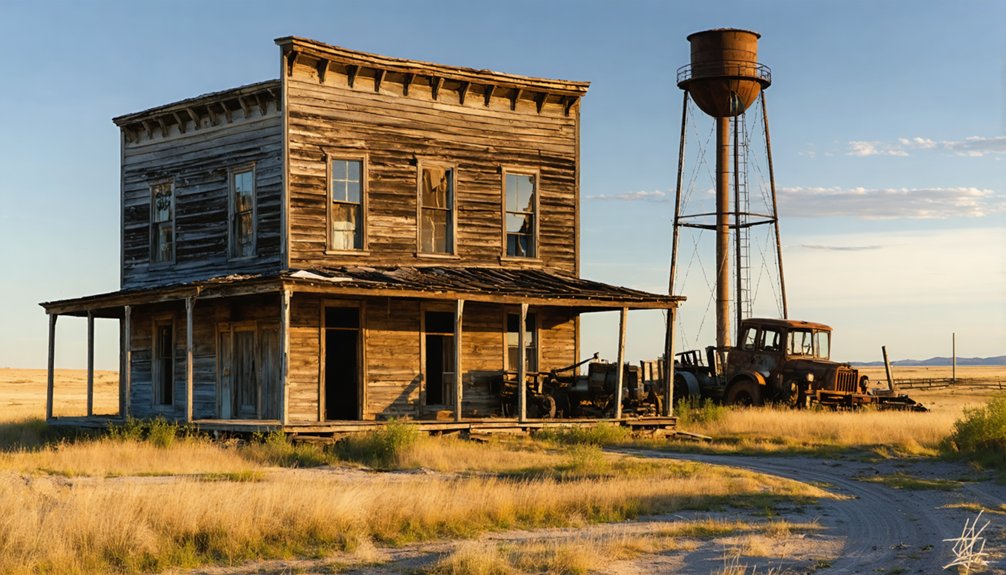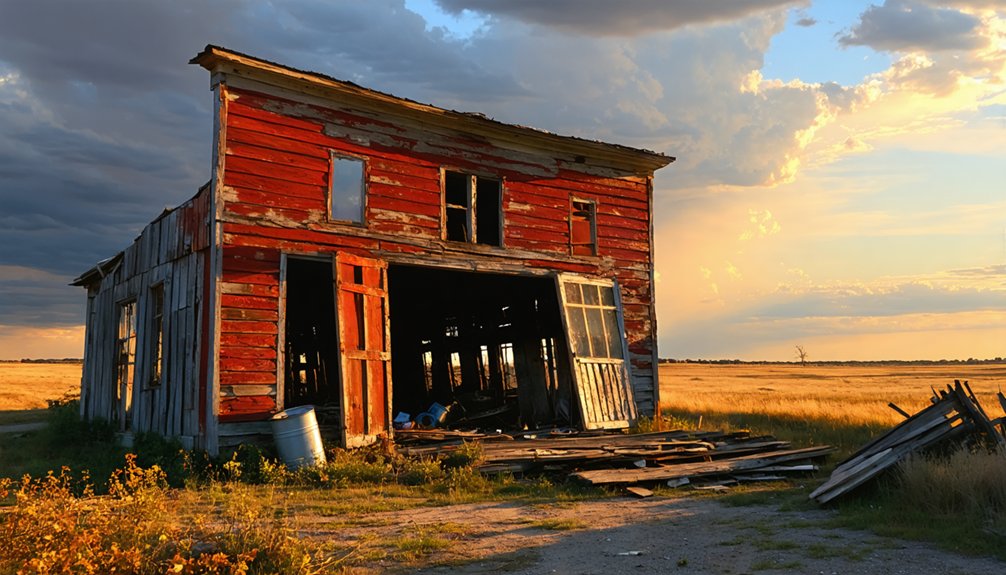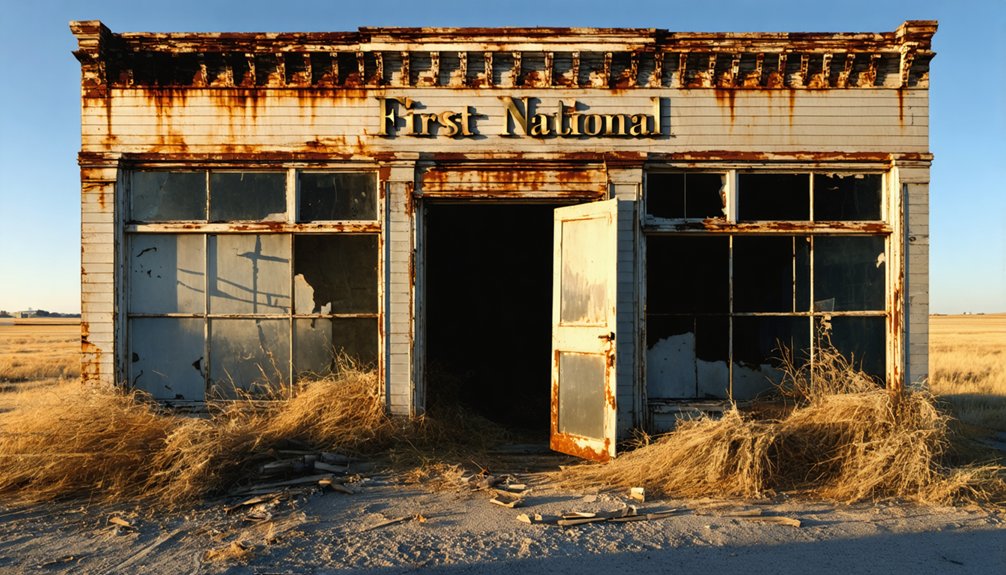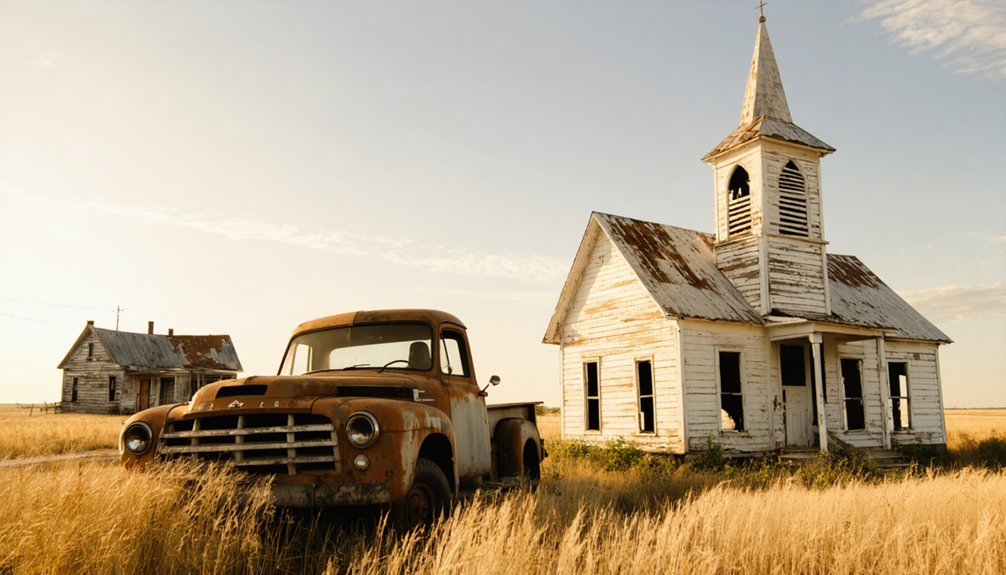You’ll find Montezuma nestled in South Dakota’s Black Hills, where gold was discovered in 1876 by M.D. Rochford and his companions. This former boomtown quickly grew to 500 residents, with miners working grueling 12-hour shifts in search of gold and silver riches. After the devastating silver market crash of 1893, the once-bustling community transformed into a ghost town. Today, no original structures remain at the site, though its rich mining heritage continues to intrigue visitors.
Key Takeaways
- Montezuma became a ghost town following the 1893 silver market crash, which devastated local mining operations and forced residents to abandon the area.
- No physical structures, foundations, or community infrastructure remain visible at the former townsite in South Dakota’s Black Hills region.
- The town’s population peaked at 500 residents during the 1870s Black Hills gold and silver rush before its eventual abandonment.
- Located in Pennington County at 5,761 feet elevation, Montezuma emerged from gold discoveries in quartz veins within metamorphic rocks.
- The site serves as a historical testament to the boom-and-bust cycle of mining communities in the American West.
The Discovery of Gold on Montezuma Hill
Fortune smiled on three hunters from Deadwood in August 1876 when they stumbled upon gold-bearing rock while tracking game on Montezuma Hill. M.D. Rochford, Richard B. Hughes, and William Van Fleet made this accidental gold discovery at an elevation of 5,761 feet in Pennington County’s northern Black Hills.
You’ll find this discovery came during the peak of the Black Hills gold rush, just months after the famous Homestake lode discovery near Lead.
The gold at Montezuma Hill lay within quartz veins measuring one to four feet thick, embedded in metamorphic rocks. While prospectors throughout the region were already using mining techniques like crushing and mercury amalgamation, this new find sparked a rush that would establish the Rochford Mining District and transform the area. By December 1877, the booming settlement had grown to include 500 permanent residents. Similar to the San Diego County deposits, these veins were found in quartzite and schist formations.
Early Settlement and Town Development
When miners flocked to Montezuma Hill in 1876, they established a settlement that would quickly evolve into a bustling frontier town. The area’s rugged terrain and proximity to natural resources attracted diverse settlers, from European immigrants seeking new opportunities to homesteaders drawn by the promise of 160 free acres under the Homestead Act of 1862. Like early fur trading posts that dominated South Dakota’s economy in the 1830s, Montezuma became an important commercial center for the region. The town emerged during a period when the Dakota Territory population grew from 80,000 to 325,000 between 1878 and 1887.
Settler motivations and community dynamics shaped Montezuma’s development in three distinct ways:
- The town emerged as an essential service hub, with general stores and saloons supporting both mining operations and local residents.
- Railroad expansion in the 1880s connected the community to larger markets, boosting economic growth.
- Social institutions and community buildings were established to transform the settlement from a temporary mining camp into a permanent town.
Life in a Black Hills Mining Community
You’d find Montezuma’s daily routine centered on the grueling work shifts that kept miners underground for up to twelve hours, equipped with carbide lamps and emerging covered in dust from the cramped tunnels.
Like many mining operations that emerged after the Homestake claim discovery in 1876, the work was demanding but potentially rewarding for those who struck it rich.
After dark, the town’s social life revolved around the saloons and gambling halls, where card games and drinking provided escape from the harsh realities of mining life.
Most miners initially searched for placer gold deposits in the creeks and soil before attempting more complex mining operations.
Women in the primarily male community ran boarding houses, worked as laundresses, or managed small businesses that served the miners’ basic needs.
Daily Mining Town Routines
Life in Black Hills mining towns revolved around the demanding rhythms of underground work and basic survival. You’d spend long hours wielding pickaxes and shovels in the depths, extracting gold from deep veins rather than simple stream panning. Families worked together to ensure survival, with wives facing 15-hour days of relentless household chores. Seth Bullock served as the local sheriff, maintaining order in the bustling mining community.
Mining techniques evolved from surface placer mining to more complex underground operations as easily accessible deposits ran out.
- Your claim was your lifeline – protected by unwritten laws while you were in town, though claim disputes and theft remained constant threats.
- You’d rely heavily on your neighbors, gathering in crowded cabins for support and socialization despite the harsh conditions.
- When not working underground, you’d find community at the local saloon, though these gatherings often sparked violence and disorder.
Social Scene After Dark
As darkness settled over the Black Hills mining communities, social life buzzed with activity in the town’s bustling saloons and gathering spots. You’d find yourself drawn to the nightlife nostalgia of places like the Inferno Bar, a converted mine stope that pulsed with live music and laughter during the Days of ’76 celebrations.
The ghostly gatherings of these mining communities often spilled into outdoor parties, where the spirit of freedom and camaraderie thrived. During peak events, vehicles would line up for half a mile long as thousands flocked to join the festivities. Modern venues like Moonshine Gulch Saloon continue this tradition of lively gatherings in the Black Hills today.
Like many Black Hills towns, Montezuma’s social scene centered around its saloons, where you could join locals for drinks, music, and community events.
These venues weren’t just bars – they were cultural hubs where miners unwound, shared stories, and forged lasting bonds after long days underground.
Women’s Roles and Work
While men toiled in the mines, women in Montezuma played equally essential roles that kept the community functioning and thriving. Their entrepreneurship flourished as they established and managed crucial businesses like boarding houses, providing miners with clean lodging and hot meals.
Women’s contributions to Montezuma included:
- Running home-based enterprises, including laundry services and sewing businesses, while maintaining household gardens and livestock.
- Taking on community leadership roles by organizing social events, church functions, and charitable activities to support struggling families.
- Forming support networks with other women to combat isolation, sharing childcare duties, and providing critical healthcare services in the remote mining camp.
Despite legal and cultural restrictions of the era, you’ll find that women’s resilience and resourcefulness were fundamental to Montezuma’s survival.
The Silver Rush Years and Peak Population

You’ll find Montezuma’s most prosperous period emerged during the late 1870s, when the discovery of rich silver and gold deposits drew more than 1,000 people to the area.
The town quickly developed essential infrastructure, including six stores, three saloons, and a Methodist Episcopal Church to serve the bustling population of 500 residents and 500 prospectors in the surrounding hills.
Mining Boom Draws Thousands
During the height of Black Hills mining activity, Montezuma experienced an unprecedented population surge as thousands of fortune seekers flooded the area. The gold rush transformed this once-quiet region into a bustling hub of activity, as mining migration brought diverse groups seeking economic opportunities.
The rapid influx of people sparked dramatic changes to the landscape and community:
- Mining companies quickly established operations, creating jobs both underground and in support industries.
- Railroads and transportation networks expanded to move ore and supplies.
- New businesses, housing, and social venues emerged to serve the growing population.
You’d have found a vibrant mix of miners, engineers, merchants, and their families, all drawn by the promise of prosperity.
The town’s demographics shifted from primarily transient males to settled families as the community matured and mining operations stabilized.
Silver Fuels Town Growth
As silver deposits emerged alongside gold in the Black Hills’ schist formations, Montezuma’s mining operations expanded dramatically in the late 1870s.
You’d have found sophisticated silver extraction methods targeting argentite ore in replacement-type deposits, with mining technology adapted to the challenging mountainous terrain at 5,761 feet.
The boom transformed Montezuma and nearby Rochford into thriving communities. By December 1878, Rochford’s population had swelled to 500 residents, with affordable lots priced between $10 and $60 drawing enthusiastic settlers.
The Black Hills Development and Financial Co. established underground mining operations, while the towns bustled with three saloons, six stores, and over 100 homes. A Methodist Episcopal Church and multiple doctors served the growing population, as silver mining complemented gold production to sustain the local economy.
Notable Buildings and Infrastructure
While historical records from South Dakota’s ghost towns often detail surviving structures and infrastructure, Montezuma presents a unique challenge due to the complete absence of documented buildings or physical remains.
Unlike other abandoned towns in the region where you’ll find traces of the past, Montezuma’s architecture and infrastructure remnants have vanished completely from the landscape.
Time has erased all physical traces of Montezuma, leaving behind no remnants of its existence in South Dakota’s landscape.
Current research reveals:
- No standing structures, foundations, or building materials remain visible at the townsite.
- Transportation infrastructure, including roads and railway features, has disappeared without documented evidence.
- Community structures like schools, churches, and commercial buildings haven’t survived, leaving no physical markers of the town’s former layout.
This complete absence of structural remains makes Montezuma particularly mysterious among South Dakota’s ghost towns.
Entertainment and Social Scene

Despite the absence of physical structures today, Montezuma’s entertainment and social scene once pulsed with vibrant activity. You’d find miners and townsfolk gathering at the town’s saloons, where card games, gambling, and storytelling filled the evenings.
Dance halls hosted lively social gatherings that brought the community together, while seasonal festivities marked the mining calendar with celebratory events.
The Methodist Episcopal church served as both a religious and social cornerstone, while the post office doubled as a communication hub where residents exchanged news and stories.
You wouldn’t just find single miners enjoying themselves – families participated in community events, creating a rich social fabric that sustained the town during its boom years.
Hotels and boarding houses fostered connections among permanent residents and transient workers alike.
Mining Operations and Economic Growth
The 1876 discovery of gold in Montezuma Hill transformed this quiet Black Hills location into a bustling mining hub within the Rochford Mining District.
You’ll find underground mining techniques were fundamental in extracting gold and silver from the replacement deposits nestled within Neoproterozoic slate. The area’s rapid growth sparked development of homes, stores, and saloons, while creating essential employment opportunities for the community.
- Mining operations focused on extracting precious metals like gold and silver, along with sulfur-pyrite.
- Environmental impact considerations were critical due to the mine’s location within Black Hills National Forest.
- The economic boom attracted miners in droves, leading to significant population growth by 1878.
Today, you can still witness the mining industry’s lasting influence on local economic strategies and historical preservation efforts, though operators faced challenges with environmental compliance and geological complexities.
The Silver Market Crash of 1893

The silver market’s devastating collapse in 1893 sent shockwaves through Montezuma’s mining operations, as silver prices plummeted from 83 to 62 cents per ounce.
You’ll find that this crash forced many of the town’s mines to close, leaving scores of miners unemployed and creating a ripple effect throughout the local economy.
While some community members attempted to weather the crisis through relief efforts and alternative employment, the town’s recovery proved impossible as the nationwide depression deepened into 1894.
Economic Fallout and Impact
When silver prices plummeted from 83 to 62 cents per ounce in 1893, mining communities across South Dakota faced devastating economic consequences.
The economic collapse forced mines to slash wages or shut down completely, leaving countless workers unemployed and desperate for survival.
Here’s how the crisis unfolded in mining towns:
- Labor disputes erupted as companies cut wages, but workers couldn’t resist since they’d be easily replaced.
- Local banks failed without federal insurance, wiping out many families’ life savings.
- Businesses throughout the region collapsed as unemployed miners flooded nearby cities searching for work.
You’ll find that this devastating period transformed bustling mining communities into ghost towns, as workers and their families were forced to abandon their homes in search of opportunities elsewhere.
Recovery Attempts and Changes
After silver prices collapsed in 1893, Montezuma’s leaders launched desperate attempts to stabilize their declining community through economic diversification.
You’ll find their community resilience reflected in how they repositioned the town as a service hub, maintaining essential operations like the post office, schoolhouse, and church to attract families and preserve resident life.
Despite the devastating economic impact, local entrepreneurs didn’t give up. They worked to establish alternative businesses while the Montezuma Mill Run newspaper continued publishing to maintain community bonds.
The town’s economic diversification efforts included promoting restaurants, boarding houses, and entertainment venues to serve nearby mining communities.
While some residents clung to hopes of a silver industry revival through technological improvements, most attempts at renewal faced steep challenges amid the regional downturn.
Preservation and Enduring Legacy
Preservation efforts throughout South Dakota’s ghost towns, including Montezuma, reflect a delicate balance between maintaining historical integrity and promoting responsible tourism.
You’ll find these historical sites face significant preservation challenges, from structural decay to limited funding, yet their historical significance makes protection essential.
- Local historical societies work to protect these open-air museums through education, published journals, and controlled access policies.
- Ghost towns serve as living classrooms where you can explore mining history, settlement stories, and cultural heritage through guided visits.
- The sites foster economic growth through heritage tourism, creating opportunities for local businesses while maintaining sustainable practices.
You’re encouraged to participate in preservation by following site guidelines, attending educational events, and supporting local historical initiatives that keep these precious landmarks intact for future generations.
Montezuma’s Role in Black Hills History
The story of Montezuma embodies the dramatic gold rush era that transformed the Black Hills in the late 1870s. After hunters discovered gold on Montezuma Hill in 1876, you’ll find the area quickly became a focal point of mining activity that helped shape the region’s destiny.
Montezuma’s significance extends beyond its own boundaries. As part of the Rochford Mining District, it contributed to a network of mining communities that included Deadwood and Lead, creating an economic ecosystem that drove the Black Hills’ development.
While the Montezuma mining legacy might seem modest compared to its more famous neighbors, it played a crucial role in the area’s transformation from indigenous territory to a thriving mining region, drawing hundreds of prospectors and supporting numerous auxiliary businesses that defined the American frontier experience.
Frequently Asked Questions
What Happened to the Original Mining Equipment After the Town’s Decline?
You’ll find most mining equipment was either dismantled and moved to other Black Hills sites, scrapped during wartime metal drives, or left to rust, with some pieces preserved for historical preservation.
Were There Any Notable Native American Conflicts During Montezuma’s Early Years?
You’ll find records of local skirmishes following broken Native American treaties in the area, though no major battles occurred directly in Montezuma during its early settlement period.
How Did Residents Access Medical Care During Harsh Winter Months?
You’d stock winter supplies and rely on neighbors with sleds for emergency transportation. When doctors couldn’t reach you, you’d use home remedies passed down through generations and pray the community would help.
What Was the Average Monthly Wage for Miners in Montezuma?
You’d have earned between $48-$96 monthly as a miner in the late 1800s. Mining wages fluctuated based on economic impact, with skilled workers at larger operations making the higher end.
Did Any Famous Outlaws or Historical Figures Visit the Town?
You won’t find documented evidence of famous visitors or outlaw legends in Montezuma. While nearby towns like Deadwood attracted Wild Bill Hickok and Calamity Jane, Montezuma’s history centers on local miners.
References
- https://www.legendsofamerica.com/rochford-south-dakota/
- https://coloradosghosttowns.com/Montezuma Colorado.html
- https://www.sdpb.org/rural-life-and-history/2023-08-21/some-black-hills-ghost-towns-and-their-origins
- https://www.youtube.com/watch?v=_0WNYsFLSLA
- https://summithistorical.org/landscapes/townsites/montezuma/
- https://www.powderhouselodge.com/black-hills-attractions/fun-attractions/ghost-towns-of-western-south-dakota/
- https://www.blackhillsbadlands.com/blog/post/old-west-legends-mines-ghost-towns-route-reimagined/
- https://en.wikipedia.org/wiki/List_of_ghost_towns_in_South_Dakota
- https://b1027.com/south-dakota-has-an-abundance-of-ghost-towns/
- https://us1033.com/october-superstitions-north-dakota/



